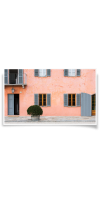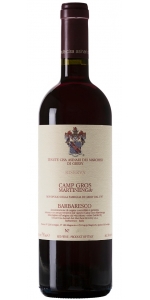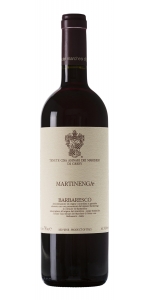Wine from Tenute Cisa Asinari

With an extension of about 45 hectares of vineyards distributed between the hills of the Langhe and Monferrato, the Tenute Cisa Asinari dei Marchesi di Grésy are a historic Piedmontese winemaking reality, whose roots go back to the end of the 18th century.
We always produce elegant wines, suitable for both daily consumption and great celebrations.
We want to be able to bring the great class of our vineyard into the bottle, with all the nuances of the territory.
This is why our work is largely concentrated in the care of the vineyard.
Marchesi Di Gresy Barbaresco Martinenga Camp Gros Riserva is made from 100 percent Nebbiolo.
Review:
Gorgeous scents of cherry, raspberry, rose hip and white pepper are augmented by leather, tobacco and chalky, mineral flavors in this detailed, complex red, which starts out fresh and inviting, before the dense matrix of tannins puts a lock on the finish. Nonetheless, this has length, harmony and stellar potential. Best from 2025 through 2043. 663 cases made, 50 cases imported.
-Wine Spectator 96 Points
Tenute Cisa Asinari Marchesi di Gresy Gaiun Martinenga Barbaresco 2016.
Bright garnet red with slight orange reflections. Intense and pleasant hints of plum and cherry blend sinuously with balsamic nuances of mint, tea leaves, dried flowers and blond pipe tobacco.
- back
Selected Options
Wineries
Categories
Pricing
Countries
Regions
Grape Types
Wineries
Organic/Free Shipping
Henschke Henry's Seven Red Blend is made from 72% Shiraz, 13% Grenache, 12% Mataro, 3% Viognier.
20th ANNIVERSARY VINTAGE
Deep ruby with violet hues. Lifted raspberry, red currant, mulberry and Satsuma plum, with floral notes of violets, lavender, crushed flowering herbs and anise, pepper and mace spice. A rich and intense palate of well defined, concentrated red fruits; red currant, cut plum and spicy wild berries, give way to crunchy mid palate, firm-edged velvety tannins and excellent length.
Review:
Aromas of black fruit and green tobacco with bark and wet-earth undertones, following through to a medium to full body, creamy tannins and a juicy, savory finish. Intense and balanced.
-James Suckling 95 Points
Walt Clos Pepe Pinot Noir is made from 100 percent Pinot Noir.
Deep ruby in color, the wine carries luscious fruit aromas of blackberry preserves and dark cherry, infused with exotic notes of spice, black tea and pomegranate. The palate opens to a dense and velvety texture laced with flavors of barrel char and salinity, leading to a structured and focused finish.
Review:
Big and rich, with luscious spiciness to the plush dark fruit and berry flavors that are supported by medium-grained tannins. There's plenty of creamy and toasty accents on the open-textured finish.
-Wine Spectator 93 Points
Another Sta. Hills release, the 2019 Pinot Noir Clos Pepe Vineyard saw 10% stems and 10 months in 40% new French oak. It's a little more focused and firm, with classic ripe black raspberry, red plum, and cherry fruits as well as orange blossom, spice, and floral nuances. It too is medium-bodied, textured, and beautifully balanced.
-Jeb Dunnuck 93 Points






